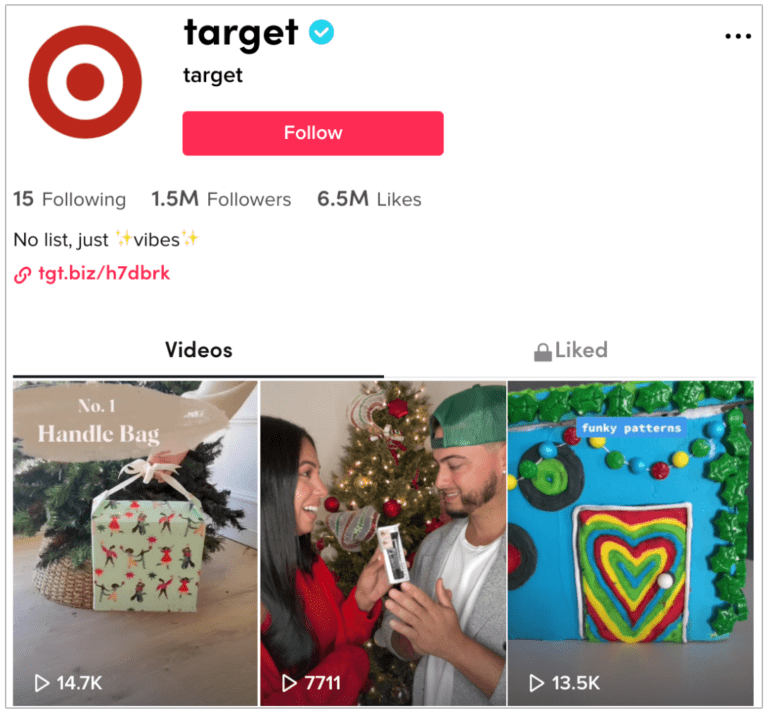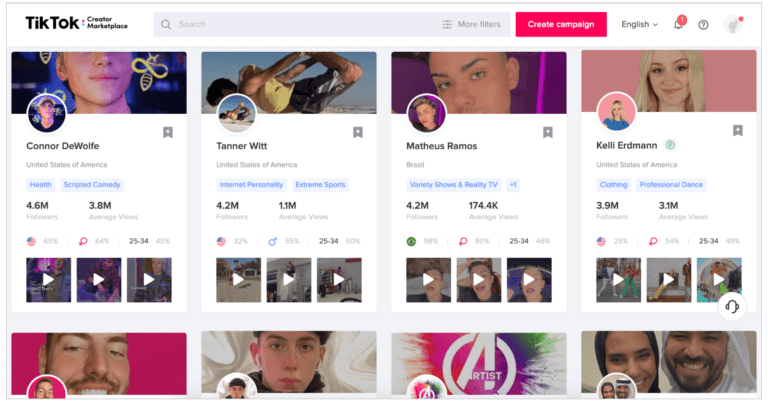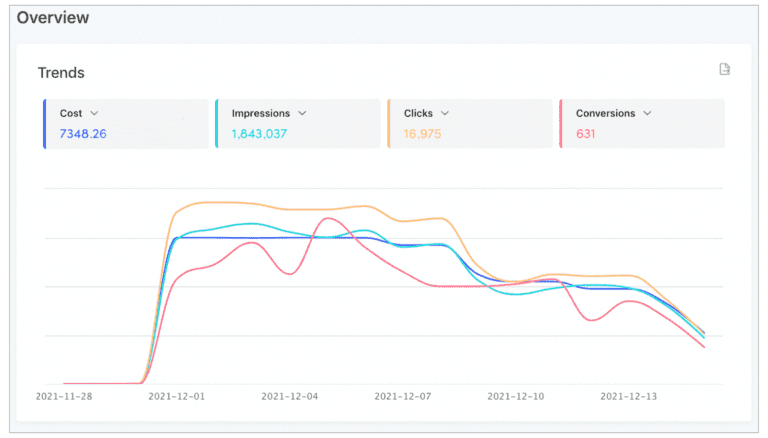How to Create a Successful Marketing Campaign on TikTok
Want to advertise and build your brand on the most downloaded app of 2021? Look no further.
The raging social media app TikTok has been around since 2018, but it’s quickly garnering mainstream traction. TikTok is used by everyone – and I mean everyone, from celebrities to teenagers to hip grans. But how beneficial is TikTok as a marketing tool?
Superficially, the platform appears to be a destination for comical lip-sync videos, rather than a medium for promoting products and services. However, there’s great potential for businesses to leverage TikTok and reach out to their customers in unique ways. And as our team has seen first-hand, TikTok has the potential to easily outperform other social media advertising platforms.

What is Tiktok, and why should you care?
TikTok presents itself as a platform for brief mobile videos. Envision a video-based Instagram or a short-form YouTube, with a slew of additional features: that’s the Tok.
TikTok videos can range in length from 5 to 60 seconds, and users can effortlessly apply filters and nifty effects to their posts. TikTok also offers an extensive music collection. Users can choose tracks to use in their videos, to overlay new sounds, and to lip-sync.
On the back end, TikTok’s algorithm employs artificial intelligence to recommend videos to users based on their previous viewings. Thanks to this algorithm, it’s simple for users to discover new material, making it easier for creators (and brands) to reach newer, bigger audiences.
The app is growing rapidly. At the end of 2021, it’s become the sixth-largest social media platform. 2022 projections? Even higher. Here are a few more staggering figures that might just persuade you to include TikTok in your marketing strategy:
- Since 2018, the TikTok app has seen over 1.65 billion downloads
- It was the most downloaded app of 2021
- The average user visits the app over eight times a day
- 53% of users are over 30 years old; however, 18-24 year-olds are the largest single demographic
How is Tiktok changing marketing?

Target’s TikTok profile
More than half of the globe uses social media, and enterprises are increasingly turning to social networking sites for advertising. Like any other medium, businesses must first research and plan content for these channels to maximize their appeal, and in turn, their ROI. However, content development can also be expensive and time-consuming, especially for people who lack the necessary tools.
This is where Tiktok comes in handy. TikTok For Business, the application’s new self-serve advertising model, enables businesses, schools, and organizations to reach a larger audience by providing simple tools for generating and analyzing content productively.
On TikTok, it doesn’t matter if you’re a first-time user, small business owner, or part of a global corporation — you can succeed with the platform as long as you tell authentic stories and maintain an active presence in the community.
In fact, TikTok ads work so well for enterprises because they allow them to engage in the viewers’ native experience. TikTok doesn’t have any annoying pop-up commercials or unskippable video ads; alternatively, ads are tastefully weaved into users’ For You feeds (TikTok’s algorithmic feed for each user). In this way, you can share your brand’s message without interfering with the overall user experience. Businesses can opt to meld in with the other suggested material or stand out to capture attention.
TikTok, unlike other applications, was created with sound in mind. According to studies, 80% of Facebook users view ads without sound. Users on most other sites similarly watch ads on silent, instead opting to read subtitles when a relevant ad plays. This is often unfortunate, because music and general audio play an important role in storytelling, communication, and emotional bonding with an audience. This is a significant creative advantage that TikTok has over other platforms.
How different is TikTok Marketing?
Marketing on TikTok is very affordable compared to other platforms. You don’t need to spend thousands of dollars on expensive, high-end video production because the app favors authentic, original content. You also don’t have to pay for tools to edit content or track your performance because the platform allows you to handle these activities on your own. Businesses can quickly capitalize on user trends to raise brand awareness and interest, generate app downloads, and boost online and offline conversions.
You can use TikTok’s Smart Video feature to create several videos from your pool of creative material, cutting back on editing time and the associated costs. For instance, the Smart Video Soundtrack tool eliminates the need to license music for an ad, while the Video Template tool streamlines the process of constructing ads from still photos.
As the social media environment becomes more intertwined, it’s common to see viral TikTok material republished on other platforms. However, while cross-posted content receives millions of hits, likes, and shares on other sites, it lacks one key feature that distinguishes TikTok from the rest: interactive audience participation.
How can marketers use TikTok?
TikTok offers an excellent avenue for businesses to reach out to consumers around the world in a fun and engaging way. Many social media fads now originate from TikTok, and being at the frontline of these trends can help brands gain credibility on the platform. TikTok does not demand massive budgets for video content generation, as spontaneous footage shot in everyday settings has just as great a chance of succeeding as anything shot with a full-scale production.
When it comes to outreach and user engagement, TikTok offers marketers a level playing field. Unlike other platforms, TikTok’s algorithm allows profiles with zero followers to garner millions of hits with a new video.
Brands can use TikTok to:
1. Begin a branded channel.
Establish a customized page and start experimenting with various sorts of content. You can quickly create content with little to no expense. The best thing to do is keep up with trending hashtags and content, and then apply that knowledge to your own posts. Create and share authentic content using the app’s built-in filters, plugins, soundtracks, and editing software. Although TikTok has vast organic reach, you can only achieve meaningful interaction if your content resonates with your viewers and adheres to the platform’s standards. Simply posting your corporate brand messaging here is not going to cut it.
2. Collaborate with influencers.

TikTok’s Collaborator Marketplace
For many businesses, influencer marketing is the bread and butter of their TikTok marketing strategy. Influencers that thrive on TikTok have built loyal fan bases by delivering relevant, high-quality content. They understand the platform and know how best to capitalize on its tools, functionalities, and trends. When you work with an influencer on an ad campaign, you can leverage their abilities and lived experiences, and not to mention their fans, for incredible results.
TikTok makes finding influencers easy with the Creator Marketplace, the platform’s own influencer marketing hub. Creator Marketplace was specifically designed to bring brands and content creators together for marketing opportunities.
3. Start a #hashtag drive.
An excellent technique for brands to build a cultural trend is to create hashtag challenges for users. Top-rated challenges can draw millions of users to a brand’s campaigns. If you want to get your content seen, you should first perform some hashtag analysis. You have to find out what hashtags are trending, what hashtags your target audience engages with, and which are relevant to your company. You can’t just use a given hashtag because it’s trending; hashtags must be relevant to your video. Otherwise, viewers who click on the hashtags will be dissatisfied, and they will not want to revisit your account.
Bear in mind that TikTok is primarily intended as a source of entertainment rather than a sales pitch. Users are looking for engaging content to keep them entertained. You should therefore use smart and strategic hashtags — as well as content — to capture your audience’s attention.
4. Advertise to new audiences.

Example of TikTok’s advertising overview dashboard
TikTok is lucrative as an ad platform because it has a similar reach to other platforms like Instagram, but is still relatively untapped by advertisers. This means that generating impressions and hits can be much more cost-effective.
At Big Sea, 2021 was our first true foray into TikTok advertising, and we can tell you — the numbers are there. In one instance, we were running a social ad campaign through both TikTok and Instagram (with unique but similar visuals across platforms). Whereas Instagram saw upwards of $9.35 cost-per-click, clicks on TikTok were only costing the campaign $0.47. Click-through rates were similarly skewed toward TikTok, in every single one of over 20 audiences.
Marketers can use the app’s dashboard to execute in-feed ads, branded hashtag challenges, and banner ads. Advertisers can target those who have viewed related content and incorporate other demographics such as age, gender, and location. Further, through the TikTok Business Manager, marketers can create and manage large-scale campaigns, various budgets and dates, and access a wealth of analytics, much like Facebook Ads Manager.
How do I set up TikTok Business Manager?
- Go to your profile page.
- On the top right corner, click the Settings and Privacy tab.
- Tap on Manage Account.
- On the top right corner, click the Settings and Privacy tab.
- Tap on Manage Account.
- Switch to Business Account from the Account Control menu.
- Select the category that accurately fits your account.
- You can then complete your profile by adding a business website and email address.
How do I create a TikTok Marketing strategy?
TikTok trends may seem random, and there’s no such thing as a foolproof marketing approach. There are, however, reasonable measures you can take to help your company succeed on the app. Here’s how to create a TikTok marketing strategy that will evolve as your TikTok experience progresses.
1. Familiarize yourself with Tiktok.
Approaching TikTok advertising the same way you would approach Instagram or Facebook would be a mistake. TikTok is an entirely different type of platform, with its own set of trends, functionalities, and user patterns.
Get yourself embroiled in TikTok videos for a while. Explore the app’s various features and keep track of which filters, sounds, and effects are popular. Keep an eye out for Branded Hashtag Challenges that involve users being asked to duplicate a task, or lip-sync to a song or dance.
Also, learn about the TikTok algorithm. Knowing how TikTok prioritizes and displays videos on the user’s feed can help you plan out your content theme and engagement strategy. Courses in the TikTok Business Learning Center can also help you sharpen up on all matters TikTok.
2. Narrow your target audience.
Find out who you hope to connect with in TikTok. Learn about TikTok demographics and find those that might be interested in your brand before you create any content.
Research your target demographic on other social media sites and see if there are any overlaps on TikTok. However, don’t count out the possibility of reaching out to new or unanticipated audiences. In addition to your core audience, there may exist segments on the platform with similar or slightly varied interests.
For instance, a comic book publisher could have an audience consisting of authors on Twitter, readers on Tumblr, and illustrators on TikTok. Once you’ve identified a target audience, find out what kinds of material they enjoy and interact with — then start coming up with content ideas for your company.
3. Run a competitive audit.
If your competitors are using TikTok, then you’re already missing out on the action. If they aren’t active on TikTok, this may be a way to gain a competitive advantage. Find at least 4 – 5 similar brands and check what they’re doing on the platform. Make an effort to learn from what has succeeded and what hasn’t.
Don’t rule out integrating TikTok celebrities and influencers into your TikTok marketing endeavors, since TikTok is a creator-pioneered platform. Find individuals who are experts in your field, be it education, eCommerce, or nonprofit.
4. Set goals that align with your objectives.
You can make TikTok videos just for entertaining your audience, but it’s ideal to have specific aims that are related to your overarching business goals. Whether you’re trying to reach a new audience, raise brand awareness, or strengthen customer connections through engagement on the platform, it’s crucial to have a rationale for your initiatives. Use the S.M.A.R.T. goal model or another framework to make effective goals, and review your performance frequently.
Final Word: TikTok for the big win.
The prominence of video in social media has made it a valuable tool for connecting with prospective clients and customers. It’s time your brand reaped the rewards from this wave. Remember, there’s no such thing as an ultimate recipe for gaining traction in TikTok. Allow yourself to be innovative, have fun, and go with the stream. If an experiment doesn’t yield the desired results, learn from it and move on to the next one. You can always reach out to us for further guidance.
